Jilong Wang
Track Any Motions under Any Disturbances
Sep 17, 2025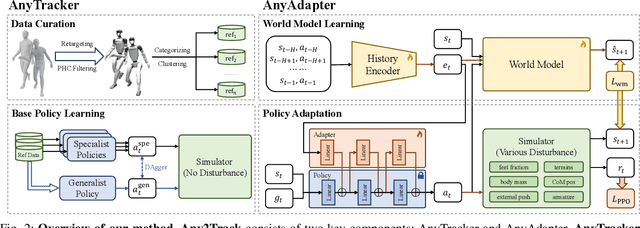

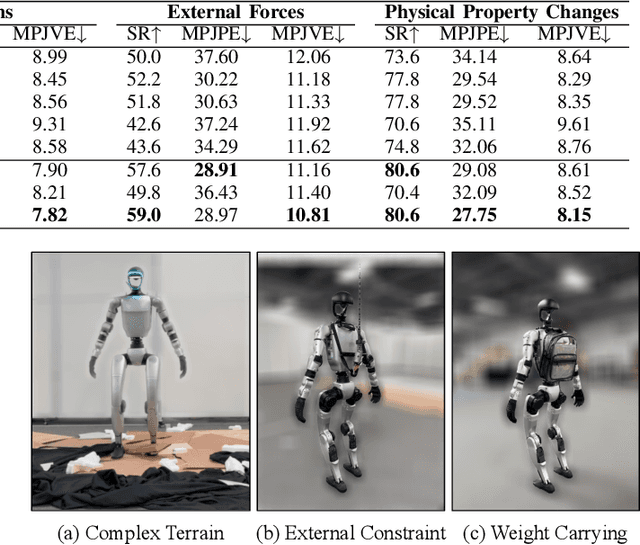

Abstract:A foundational humanoid motion tracker is expected to be able to track diverse, highly dynamic, and contact-rich motions. More importantly, it needs to operate stably in real-world scenarios against various dynamics disturbances, including terrains, external forces, and physical property changes for general practical use. To achieve this goal, we propose Any2Track (Track Any motions under Any disturbances), a two-stage RL framework to track various motions under multiple disturbances in the real world. Any2Track reformulates dynamics adaptability as an additional capability on top of basic action execution and consists of two key components: AnyTracker and AnyAdapter. AnyTracker is a general motion tracker with a series of careful designs to track various motions within a single policy. AnyAdapter is a history-informed adaptation module that endows the tracker with online dynamics adaptability to overcome the sim2real gap and multiple real-world disturbances. We deploy Any2Track on Unitree G1 hardware and achieve a successful sim2real transfer in a zero-shot manner. Any2Track performs exceptionally well in tracking various motions under multiple real-world disturbances.
Exploring Generalized Gait Recognition: Reducing Redundancy and Noise within Indoor and Outdoor Datasets
May 21, 2025Abstract:Generalized gait recognition, which aims to achieve robust performance across diverse domains, remains a challenging problem due to severe domain shifts in viewpoints, appearances, and environments. While mixed-dataset training is widely used to enhance generalization, it introduces new obstacles including inter-dataset optimization conflicts and redundant or noisy samples, both of which hinder effective representation learning. To address these challenges, we propose a unified framework that systematically improves cross-domain gait recognition. First, we design a disentangled triplet loss that isolates supervision signals across datasets, mitigating gradient conflicts during optimization. Second, we introduce a targeted dataset distillation strategy that filters out the least informative 20\% of training samples based on feature redundancy and prediction uncertainty, enhancing data efficiency. Extensive experiments on CASIA-B, OU-MVLP, Gait3D, and GREW demonstrate that our method significantly improves cross-dataset recognition for both GaitBase and DeepGaitV2 backbones, without sacrificing source-domain accuracy. Code will be released at https://github.com/li1er3/Generalized_Gait.
Unleashing Humanoid Reaching Potential via Real-world-Ready Skill Space
May 16, 2025Abstract:Humans possess a large reachable space in the 3D world, enabling interaction with objects at varying heights and distances. However, realizing such large-space reaching on humanoids is a complex whole-body control problem and requires the robot to master diverse skills simultaneously-including base positioning and reorientation, height and body posture adjustments, and end-effector pose control. Learning from scratch often leads to optimization difficulty and poor sim2real transferability. To address this challenge, we propose Real-world-Ready Skill Space (R2S2). Our approach begins with a carefully designed skill library consisting of real-world-ready primitive skills. We ensure optimal performance and robust sim2real transfer through individual skill tuning and sim2real evaluation. These skills are then ensembled into a unified latent space, serving as a structured prior that helps task execution in an efficient and sim2real transferable manner. A high-level planner, trained to sample skills from this space, enables the robot to accomplish real-world goal-reaching tasks. We demonstrate zero-shot sim2real transfer and validate R2S2 in multiple challenging goal-reaching scenarios.
FetchBot: Object Fetching in Cluttered Shelves via Zero-Shot Sim2Real
Feb 25, 2025

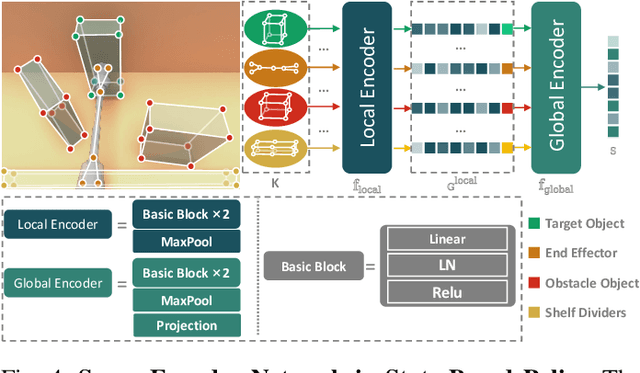

Abstract:Object fetching from cluttered shelves is an important capability for robots to assist humans in real-world scenarios. Achieving this task demands robotic behaviors that prioritize safety by minimizing disturbances to surrounding objects, an essential but highly challenging requirement due to restricted motion space, limited fields of view, and complex object dynamics. In this paper, we introduce FetchBot, a sim-to-real framework designed to enable zero-shot generalizable and safety-aware object fetching from cluttered shelves in real-world settings. To address data scarcity, we propose an efficient voxel-based method for generating diverse simulated cluttered shelf scenes at scale and train a dynamics-aware reinforcement learning (RL) policy to generate object fetching trajectories within these scenes. This RL policy, which leverages oracle information, is subsequently distilled into a vision-based policy for real-world deployment. Considering that sim-to-real discrepancies stem from texture variations mostly while from geometric dimensions rarely, we propose to adopt depth information estimated by full-fledged depth foundation models as the input for the vision-based policy to mitigate sim-to-real gap. To tackle the challenge of limited views, we design a novel architecture for learning multi-view representations, allowing for comprehensive encoding of cluttered shelf scenes. This enables FetchBot to effectively minimize collisions while fetching objects from varying positions and depths, ensuring robust and safety-aware operation. Both simulation and real-robot experiments demonstrate FetchBot's superior generalization ability, particularly in handling a broad range of real-world scenarios, includ
Watch Less, Feel More: Sim-to-Real RL for Generalizable Articulated Object Manipulation via Motion Adaptation and Impedance Control
Feb 20, 2025Abstract:Articulated object manipulation poses a unique challenge compared to rigid object manipulation as the object itself represents a dynamic environment. In this work, we present a novel RL-based pipeline equipped with variable impedance control and motion adaptation leveraging observation history for generalizable articulated object manipulation, focusing on smooth and dexterous motion during zero-shot sim-to-real transfer. To mitigate the sim-to-real gap, our pipeline diminishes reliance on vision by not leveraging the vision data feature (RGBD/pointcloud) directly as policy input but rather extracting useful low-dimensional data first via off-the-shelf modules. Additionally, we experience less sim-to-real gap by inferring object motion and its intrinsic properties via observation history as well as utilizing impedance control both in the simulation and in the real world. Furthermore, we develop a well-designed training setting with great randomization and a specialized reward system (task-aware and motion-aware) that enables multi-staged, end-to-end manipulation without heuristic motion planning. To the best of our knowledge, our policy is the first to report 84\% success rate in the real world via extensive experiments with various unseen objects.
MobileH2R: Learning Generalizable Human to Mobile Robot Handover Exclusively from Scalable and Diverse Synthetic Data
Jan 08, 2025



Abstract:This paper introduces MobileH2R, a framework for learning generalizable vision-based human-to-mobile-robot (H2MR) handover skills. Unlike traditional fixed-base handovers, this task requires a mobile robot to reliably receive objects in a large workspace enabled by its mobility. Our key insight is that generalizable handover skills can be developed in simulators using high-quality synthetic data, without the need for real-world demonstrations. To achieve this, we propose a scalable pipeline for generating diverse synthetic full-body human motion data, an automated method for creating safe and imitation-friendly demonstrations, and an efficient 4D imitation learning method for distilling large-scale demonstrations into closed-loop policies with base-arm coordination. Experimental evaluations in both simulators and the real world show significant improvements (at least +15% success rate) over baseline methods in all cases. Experiments also validate that large-scale and diverse synthetic data greatly enhances robot learning, highlighting our scalable framework.
QuadWBG: Generalizable Quadrupedal Whole-Body Grasping
Nov 11, 2024



Abstract:Legged robots with advanced manipulation capabilities have the potential to significantly improve household duties and urban maintenance. Despite considerable progress in developing robust locomotion and precise manipulation methods, seamlessly integrating these into cohesive whole-body control for real-world applications remains challenging. In this paper, we present a modular framework for robust and generalizable whole-body loco-manipulation controller based on a single arm-mounted camera. By using reinforcement learning (RL), we enable a robust low-level policy for command execution over 5 dimensions (5D) and a grasp-aware high-level policy guided by a novel metric, Generalized Oriented Reachability Map (GORM). The proposed system achieves state-of-the-art one-time grasping accuracy of 89% in the real world, including challenging tasks such as grasping transparent objects. Through extensive simulations and real-world experiments, we demonstrate that our system can effectively manage a large workspace, from floor level to above body height, and perform diverse whole-body loco-manipulation tasks.
GAMMA: Graspability-Aware Mobile MAnipulation Policy Learning based on Online Grasping Pose Fusion
Sep 27, 2023



Abstract:Mobile manipulation constitutes a fundamental task for robotic assistants and garners significant attention within the robotics community. A critical challenge inherent in mobile manipulation is the effective observation of the target while approaching it for grasping. In this work, we propose a graspability-aware mobile manipulation approach powered by an online grasping pose fusion framework that enables a temporally consistent grasping observation. Specifically, the predicted grasping poses are online organized to eliminate the redundant, outlier grasping poses, which can be encoded as a grasping pose observation state for reinforcement learning. Moreover, on-the-fly fusing the grasping poses enables a direct assessment of graspability, encompassing both the quantity and quality of grasping poses.
Free Lunch for Gait Recognition: A Novel Relation Descriptor
Aug 28, 2023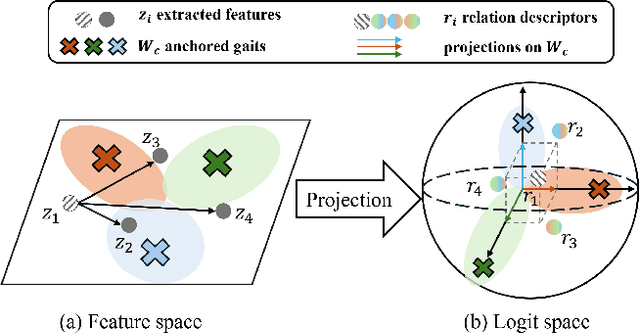
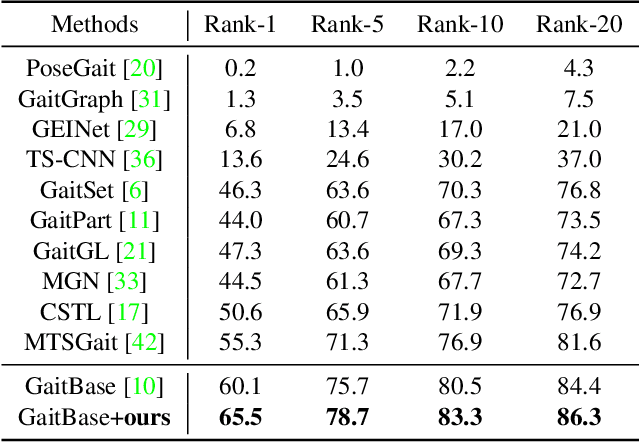
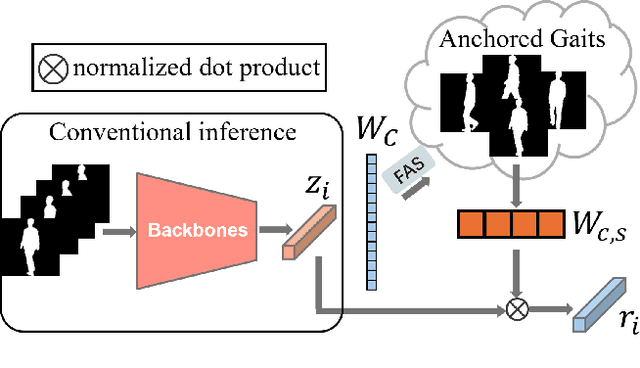
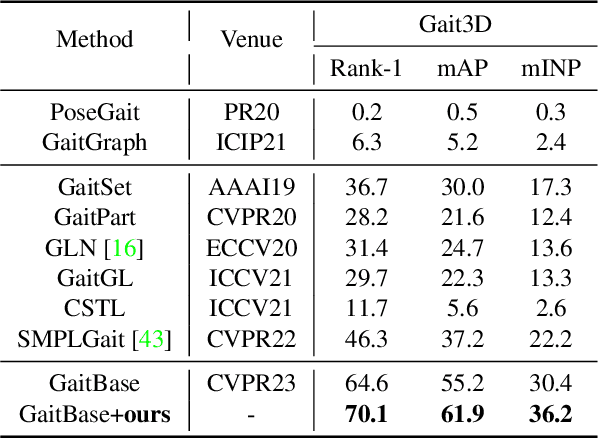
Abstract:Gait recognition is to seek correct matches for query individuals by their unique walking patterns. However, current methods focus solely on extracting individual-specific features, overlooking inter-personal relationships. In this paper, we propose a novel $\textbf{Relation Descriptor}$ that captures not only individual features but also relations between test gaits and pre-selected anchored gaits. Specifically, we reinterpret classifier weights as anchored gaits and compute similarity scores between test features and these anchors, which re-expresses individual gait features into a similarity relation distribution. In essence, the relation descriptor offers a holistic perspective that leverages the collective knowledge stored within the classifier's weights, emphasizing meaningful patterns and enhancing robustness. Despite its potential, relation descriptor poses dimensionality challenges since its dimension depends on the training set's identity count. To address this, we propose the Farthest Anchored-gait Selection to identify the most discriminative anchored gaits and an Orthogonal Regularization to increase diversity within anchored gaits. Compared to individual-specific features extracted from the backbone, our relation descriptor can boost the performances nearly without any extra costs. We evaluate the effectiveness of our method on the popular GREW, Gait3D, CASIA-B, and OU-MVLP, showing that our method consistently outperforms the baselines and achieves state-of-the-art performances.
Learning Gait Representation from Massive Unlabelled Walking Videos: A Benchmark
Jun 28, 2022


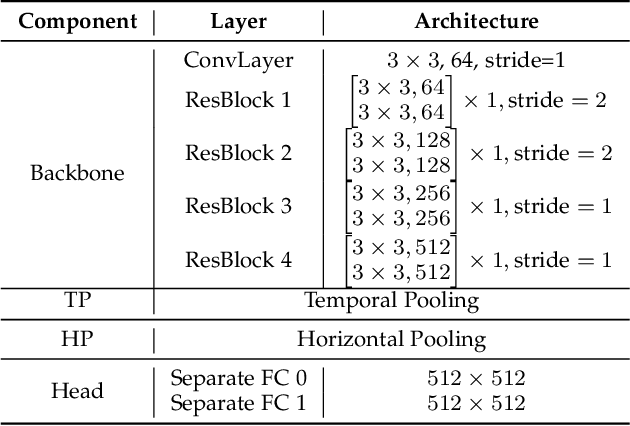
Abstract:Gait depicts individuals' unique and distinguishing walking patterns and has become one of the most promising biometric features for human identification. As a fine-grained recognition task, gait recognition is easily affected by many factors and usually requires a large amount of completely annotated data that is costly and insatiable. This paper proposes a large-scale self-supervised benchmark for gait recognition with contrastive learning, aiming to learn the general gait representation from massive unlabelled walking videos for practical applications via offering informative walking priors and diverse real-world variations. Specifically, we collect a large-scale unlabelled gait dataset GaitLU-1M consisting of 1.02M walking sequences and propose a conceptually simple yet empirically powerful baseline model GaitSSB. Experimentally, we evaluate the pre-trained model on four widely-used gait benchmarks, CASIA-B, OU-MVLP, GREW and Gait3D with or without transfer learning. The unsupervised results are comparable to or even better than the early model-based and GEI-based methods. After transfer learning, our method outperforms existing methods by a large margin in most cases. Theoretically, we discuss the critical issues for gait-specific contrastive framework and present some insights for further study. As far as we know, GaitLU-1M is the first large-scale unlabelled gait dataset, and GaitSSB is the first method that achieves remarkable unsupervised results on the aforementioned benchmarks. The source code of GaitSSB will be integrated into OpenGait which is available at https://github.com/ShiqiYu/OpenGait.
 Add to Chrome
Add to Chrome Add to Firefox
Add to Firefox Add to Edge
Add to Edge